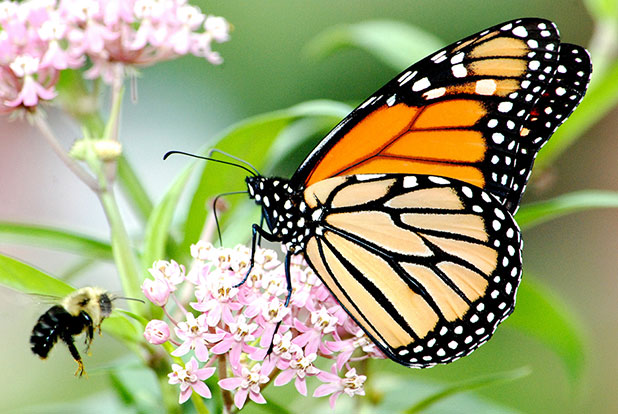Helping Our Polinators
- Category: Health
- Published: Friday, 24 July 2020 08:51
- Joanne Wallenstein
 Bees, birds and butterflies are vital to the health of our planet, and they need our help. Without pollinators, most of the Earth’s plants would not produce viable seeds and fruit which form the foundation of the food chain.
Bees, birds and butterflies are vital to the health of our planet, and they need our help. Without pollinators, most of the Earth’s plants would not produce viable seeds and fruit which form the foundation of the food chain.
Here are some easy steps to take to create a pollinator-friendly yard:
Plant native plants that attract pollinators
Native plants evolved alongside native wildlife and provide them with the right pollen and nectar for food as well as with protection and places for their young to grow. When planting flowers, make sure that a variety of plants are selected so that flowering takes place from spring through the fall.
Most nurseries sell plants that are clearly marked as attracting specific pollinators as well as specifying bloom time and sun requirements. Some examples of native plants that attract pollinators are: eastern bluestar, wild columbine, wild geranium, creeping flox, foam flower, anise hyssop, butterflyweed, common milkweed (very important for monarch butterflies) and great blue lobelia. For a more extensive list, visit SUNY’s Native Plant Center.
Avoid using pesticides
Pesticides not only kill pollinators on contact but also are absorbed by plants, thereby making their pollen poisonous. There are many organic products readily available that serve the same purpose as pesticides but are not harmful to wildlife and humans. For example, corn gluten can be used as an effective fertilizer and weed preventer, and milky spore can be used to prevent grubs. Native plants, which are best suited to our climate and terrain, are less susceptible to drought and disease so it’s even easier to avoid pesticide use when caring for them.
Reduce lawn size by creating flowerbeds
Lawns made up solely of grass are wastelands for pollinators. By carving out sections of grass and replacing them with pollinator-friendly flowerbeds, you are creating areas that are both beautiful and havens for pollinators while costing less to maintain than lawn care. (Better yet, allowing such pollinator favorites as white clover, dandelions and violets grow in your lawn--even in limited areas-- creates a friendlier yard for pollinators while acknowledging that you are helping pollinators by having a less than perfect lawn.)
Provide water
Just like any other animal, pollinators need water. Supplying water can be as simple as placing a shallow dish or saucer--that can be easily emptied and refilled --anywhere in your yard. Birdbaths are available in many sizes and materials so that they, too, can be easily maintained.
Supply shelter and nesting sites
Trees and larger shrubs are important for nesting birds. Make sure that pruning waits until late fall or early winter, after nesting season. Keeping some of the yard wild provides an undisturbed place for bees and butterflies to nest. Having a patch of bare ground and leaving leaves --or mulched leaves--on the ground provide places for them to lay their eggs and for larvae to overwinter. Even if these areas are small, every small area throughout a neighborhood adds up!
Creating a pollinator-friendly yard benefits our environment while adding beauty to the neighborhood—and it’s a great activity to share with our children. For more information, visit the US Forest Service or the Cornell Cooperative Extension.
If you have any questions or comments, contact the Scarsdale Conservation Advisory Council.







